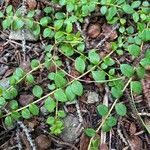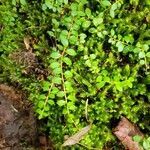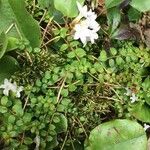Subshrubs (vinelike), creeping, mat-forming, stoloniferous; roots adventitious or fibrous. Stems repent, 10-14 cm, densely strigose. Leaf blades elliptic to oval, 0.3-1 cm, base cuneate to rounded, margins ciliate, (slightly revolute), apex acute, abaxial surface strigose, adaxial glabrous. Inflorescences axillary, solitary flowers; bracts light green, broadly lanceolate, 1.5-2 mm, exceeding sepals, sparsely strigose. Pedicels light green, 1.5-3 mm, strigose; bracteoles absent. Flowers: sepals 4, connate ca. 1/2 their lengths, white, ovate, 1-1.5 mm, hairy basally (hairs dark red); petals 4, connate 1/3 their lengths, white, 2-3.5 mm, glabrous, corolla campanulate, lobes 1.5-2 mm; filaments broadest in middle and narrowing distally and proximally, glabrous; anthers with 2 bifurcating awns, dehiscent by subterminal pores. Fruits white, 2.5-6 mm wide. 2n = 22.
More
A small creeping plant. It keeps growing from year to year. It grows 10-30 cm long. The leaves are alternate and simple. They are oval and dark green above and pale underneath. Underneath it is dotted with brown hairs. The leaves are about 5 mm long and are rolled under at the edges. The flowers are small and white. They are about 2 mm long. They occur singly in the axils of the leaves. They are cup shaped. The fruit is a white mealy berry. They are up to 1 cm across. The fruit are edible.
Coniferous forests and mountains in the alpine and sub-alpine zones. Cold wet woods and bogs. Sphagnum bogs, fens and mossy, coniferous woodland forests and swamps, often on moss-covered or rotting logs; at elevations from 30-1,400 metres.
More
It is a cool temperate plant. It grows in evergreen mossy woods. It grows on bogs and logs. It can grow in fairly wet soils. It suits hardiness zone 3.




